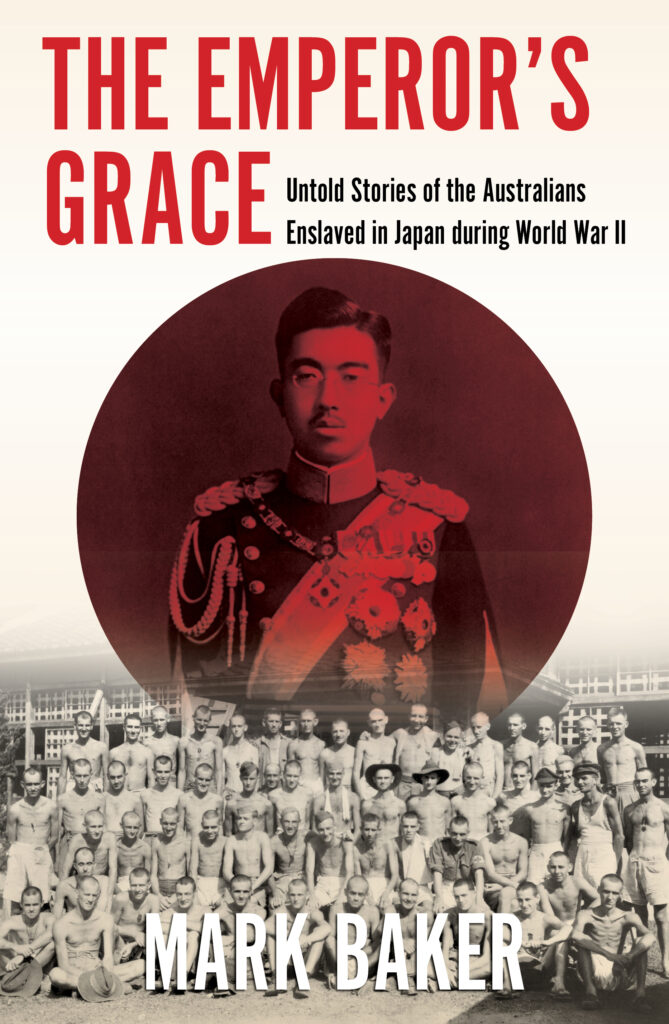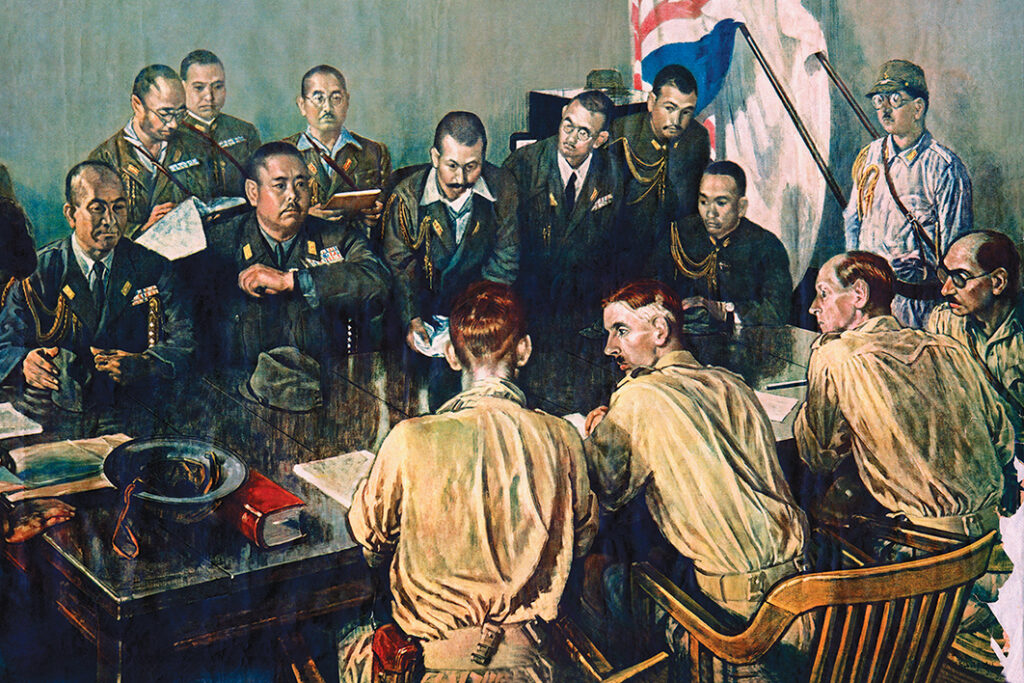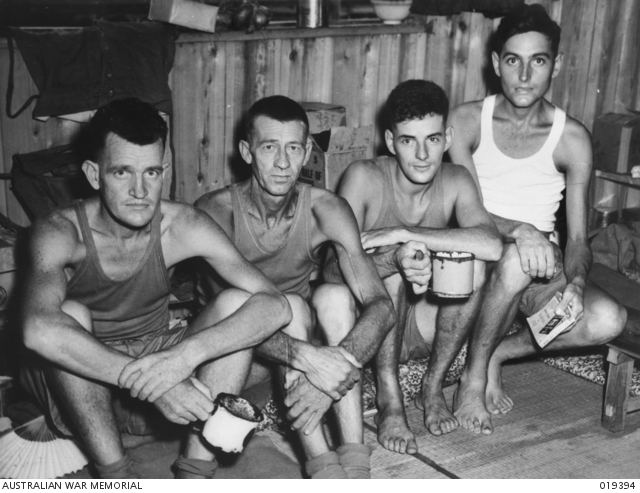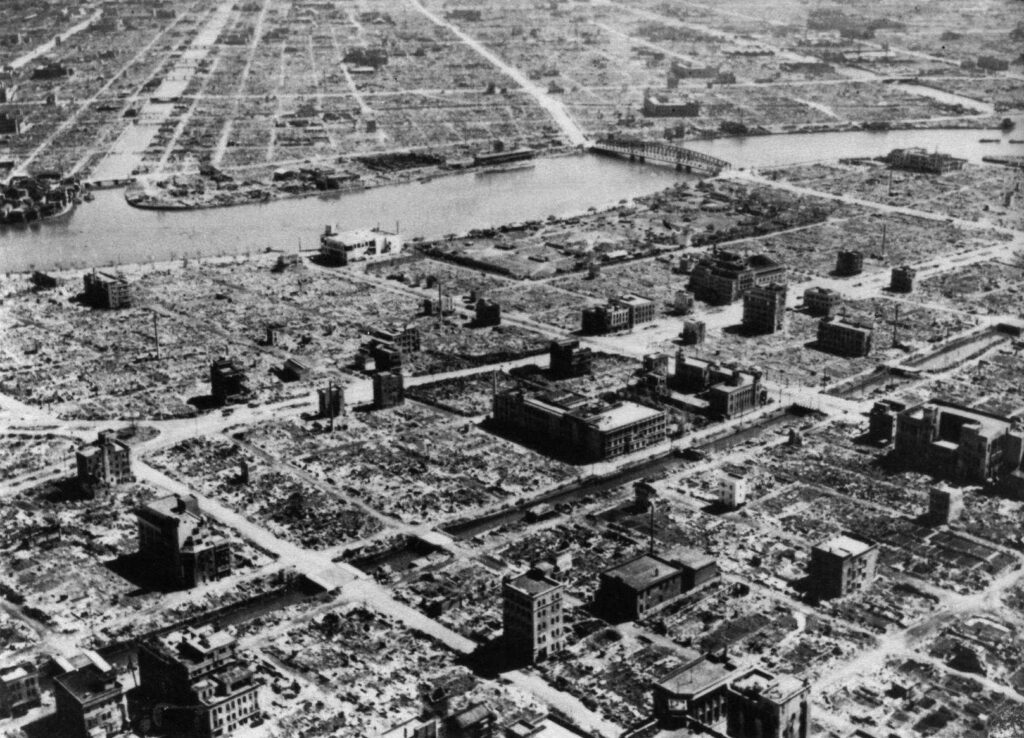‘Readable account of Australian POWs in Japan – though it lacks a bit of context’, Honest History, 14 May 2021
Kristen Alexander reviews Mark Baker’s The Emperor’s Grace: Untold Stories of the Australians Enslaved in Japan during World War II
The Emperor’s Grace is the story of C Force, the first contingent of Australian, British, and Dutch prisoners of war (POWs) shipped from Singapore to Japan in November 1942. The book focusses mainly on the men of the Australian 8th Division Signals, one of the 22nd Infantry Brigade’s support units, in particular, officers Captain John Paterson and Lieutenant Doug Lush. Baker details pre-captivity service on the Malayan peninsula, then describes the events leading to the fall of Singapore and the surrender of British and allied troops.
 When the C force volunteers arrived in Japan, some were sent to Naoetsu, and the remainder, under Paterson’s command, were taken to Kobe. There, the group of about 400 men worked at first in the Kawasaki shipyard. After Kobe was destroyed in the American firebombing campaign in March 1945, the men were sent to the Fukuoka coal mine. The Emperor’s Grace concludes with chapters dealing with the war crimes trials and a brief survey of post-war life.
When the C force volunteers arrived in Japan, some were sent to Naoetsu, and the remainder, under Paterson’s command, were taken to Kobe. There, the group of about 400 men worked at first in the Kawasaki shipyard. After Kobe was destroyed in the American firebombing campaign in March 1945, the men were sent to the Fukuoka coal mine. The Emperor’s Grace concludes with chapters dealing with the war crimes trials and a brief survey of post-war life.
Prisoners of Japan are passing from living memory. While wartime diaries continue to be discovered in family archives and shared with historians, our opportunity to record first-hand accounts now barely exists. As Baker acknowledges, The Emperor’s Grace arises from Doug Lush’s ‘determination’. Lush gathered unpublished material from his comrades and set down his thoughts and recollections in a series of commissioned interviews.
Baker has drawn on these interviews extensively as well as on other contemporary and late-life prisoner-witness sources, such as unpublished memoirs by Lloyd Ellerman and Mick Kildey, Ken Trumble’s War Diary 1942–45, Desmond Mulcahy’s Australians at War Film Archive interview, and Jack Chapman’s memoir. By far the best and most detailed source, though, is the secret wartime diary compiled by John Paterson.
The book’s title comes from a prepared statement from the Commander of Osaka POW Camp, which was read by their new commandant, Lieutenant Yasuki Morimoto, to the prisoners during their first parade at the Kobe camp: ‘You fought well but lost and were taken captives. … However, by the august virtues and grace of His Majesty, The Emperor, and also benevolence of our military authorities, you are still sound and alive, having necessary quarters to live in with clothing and food properly supplied …’
The irony of this statement (which is not sourced) was soon obvious. The POWs experienced little grace; they were nothing more than slaves. ‘That was the start of two and half years of bloody hard work’, Lush recalled. ‘These men would be worked fifteen hours straight, with only two rest days a month.’
And, as Joan Beaumont has demonstrated, work was not equal.[1] POW officers, such as Paterson and Lush, remained in camp. They supervised cleaning, organised rations, maintained discipline, and negotiated with the Japanese for coal. Non-commissioned officers like Des Mulcahy had the day-to-day management of the men in camp and at the shipyard. The men, such as Private Lloyd Ellerman, comprised the shipyard work parties; they, according to Ellerman, lived with ‘bestiality, bashings, and starvation’.
These men may have been slave labour but, when they could, they exerted agency. ‘Everyone did as little work as possible’, Ellerman wrote in 1986. They deliberately made mistakes, performed faulty work, or forced delays. ‘In other words, we never yielded to the will of our captors.’ Placing his late-life memoir firmly within the trope of the Anzac legend, Ellerman credits his survival, and that of many others, to their Australian identity and racial superiority, humour, and above all, mateship. So, too, does Lush.
Joan Beaumont and Mark Dapin have debunked the survival-by-mateship trope.[2] There is no doubt mateship was an essential driving force for the Australian POWs in Japan, but C Force’s narrators also reveal that self-preservation, even at the cost of community, was a competing survival instinct. The altruism of one man who repaired torn and worn shirts for his fellows is countered by raffles for dead men’s clothes. The ‘reckless and defiant streak’ of one man in the Kawasaki shipyards resulted in punishment for all.
Community also foundered on rank lines. The Japanese expected the POW officers such as Paterson and Lush to maintain and enforce discipline. Any lack of compliance by the men led to a formal administrative hearing and the officers had to set and enforce punishments; cigarette rations (trading currency as well as a vital coping mechanism to relieve hunger) were forfeit for those proven guilty.
More than anything, perhaps, hunger threatened community. One man stole vegetables from local gardens fertilised by nightsoil. Rather than share the vegetables, he ate them all himself, but failed to clean and cook them. He later contracted ‘toxic poisoning’ and died. While running counter to the mateship myth, frail humanity and self-interest were understood. Lush recognised that this ‘poor devil’ had been driven by hunger and overwork.
 Lieutenant General Arthur Percival surrenders Singapore to General Tomoyuki Yamashita on 15 February 1942. Saburo Miyamoto/National Museum of Modern Art, Tokyo (Inside Story)
Lieutenant General Arthur Percival surrenders Singapore to General Tomoyuki Yamashita on 15 February 1942. Saburo Miyamoto/National Museum of Modern Art, Tokyo (Inside Story)
Later, after another man, starving and grief-stricken over the death of friends, confessed to stealing two Red Cross parcels, Lush and Paterson protected him from severe punishment. Baker fails to address these contradictions. Instead of challenging the ‘Australian creed of mateship’ to present a more nuanced account of captivity, he uncritically accepts late-life claims.
Rather than present a strictly chronological account, Baker features the familiar tropes of captivity in chapters entitled ‘Sickness’, ‘Hunger’, and ‘Violence’. Death is a significant feature of Japanese captivity, but Baker does not include a section dedicated to it; stories of those who failed to survive are scattered throughout the themed chapters.
Seventeen Kobe prisoners died in the first five months, and, in total, fifty-one Allied prisoners died, including eighteen Australians. ‘The needless waste of young life is appalling, and our inability to do anything for these men is terrible’, wrote John Paterson. Baker points out that the POW dead had gone ‘unmourned by their captors’ until the death of Bob Flanagan in the shipyard’s first fatal accident. Rather than leave this event unmarked, the Japanese decided a formal ceremony had to be carried out. Paterson recorded details of the marquee that was erected, and the respects paid by the prisoners during their funeral parade; the Australians wore ‘their Aussie hats’ and looked ‘very spruce’.
Then, a prayer and the 23rd Psalm were read, and as well as Paterson’s address, Morimoto spoke, paying tribute to Flanagan’s sacrifice for the Emperor. After flowers were placed on Flanagan’s coffin, Paterson recorded, pallbearers carried it ‘to a waiting hearse which I accompanied with the medical sergeant to the crematorium’.
Three chapters later we read that the prisoners themselves ‘did their best to provide a dignified funeral’ for another man who had died. An officer said a prayer on parade before one of the medical orderlies ‘removed the body for cremation’, placed it in a bean curd barrel, and wheeled it to the nearby crematorium.
Mateship may not have prevented illness and death, but, contrary to Paterson’s lament that friends and comrades could do nothing for the sick and dying, their care provided relief, comfort, and, in some cases a lifeline. Jack Chapman recalled going to the hospital after each day’s shift at the shipyards to sit with their sick friend, Jimmy O’Connell, who survived, ‘telling him whopper lies, anything to cheer him up, home by whenever and all the food we would pig out on’. Lloyd Ellerman attested that, ‘Our medical orderlies rendered all possible care and attention – in fact they were marvellous’.
The opening quote of the ‘Changi’ chapter, by Jim Jacobs – ‘Alas for the prestige of the white man in the East’ – highlights the racist, superior, colonial attitudes of Australians towards both Japanese and ‘natives’ in the region. The Japanese are ‘monkey men’ and ‘sub human’. The language jars now but, as Lachlan Grant notes, such expressions were common at the time.[3] Baker, however, makes no attempt to contextualise this. Moreover, in the battle descriptions (which are largely unsourced), he tends to accept the notion of the heroic Australians, quoting, for example, one of the gunners from the 2/15th Field Regiment who contrasts the ‘panic-stricken ranks of Japanese bicyclists’ with the cool-headed Australians who ‘leisurely removed pins from Mills grenades’.
Perhaps understandably, the men’s racist attitudes were not tempered by years of barbarous treatment. Victory validated the whites’ superiority and Baker notes that the old racial hierarchy lost no time in re-establishing itself. Vengeance – a need for retribution and justice – perhaps underpinned the Australians’ continuing racial contempt. They reported their experiences to those gathering evidence for war crimes trials. Some of their captors were found guilty and sentenced to varying periods of hard labour.
 Australian prisoners at Osaka camp, 1945 (AWM)
Australian prisoners at Osaka camp, 1945 (AWM)
Stories of psychological disturbance are scattered throughout the themed chapters. Baker’s witnesses give examples of ‘mental cases’, and those who ‘abandoned the struggle to survive’. Paterson, particularly, suffered much mental anguish. Michael McKernan, Janet Bomford, and many others poignantly demonstrate that Japanese captivity did not end at liberation or homecoming.[4] Most recently, Christina Twomey reinforces this with detailed case studies.[5] I argue something similar for prisoners of Europe.[6]
Lush experienced psychological disturbance in post-war life and his marriage failed to survive separation but Baker does not dwell on Lush’s mental health difficulties, nor does he look at how psychological disturbance may have touched other C Force lives, including that of Paterson, who often spoke of the affective burdens of leadership. Rather than elaborate on the social and psychological challenges of resettlement and post-captivity life, ‘Home’ serves to round off some of the ‘untold stories’.
I reviewed Baker’s biography of Australian war correspondent, Phillip Schuler, for Honest History in August 2016.[7] I critiqued Baker’s fondness for quoting large extracts from secondary sources, his tendency to pad to compensate for lack of primary sources, and his bias against Keith Murdoch. Happily, there was little padding or bias in The Emperor’s Grace. Baker, however, is prone to passive narration and cliché. He again tends to over-(block) quote from secondary sources. Like Schuler, who was often absent in Baker’s biography of him, the men of C Force were little present in the opening chapters of The Emperor’s Grace.
My major criticism of The Emperor’s Grace, however, is the lack of contextualisation. I believe prisoner stories are important and their voices should predominate. But I also believe the author needs to explicate the historical context and delve into the stories behind the stories: Baker does not analyse actions, motives, emotions, or anything of the captivity experience. Perhaps I should not criticise Baker’s lack of authorial voice, analysis, and context. This, after all, would ignore the book that is written, and the clue to that is in the title: ‘untold stories of the Australians’. But The Emperor’s Grace is published by a university press, and, as such, I expected historical analysis and contexualisation of those stories.
My expectations aside, The Emperor’s Grace is eminently readable. Baker’s storytelling takes off after captivity, where he draws on prisoner-witness accounts rather than secondary sources. Some of his narrative, however, is unsourced. Like Phillip Schuler, the story flows well and is fast-paced with short chapters and keep-on-reading throws. C Force’s compelling ‘untold stories’ are recounted with sympathy and vigour; they can now rightly be claimed as ‘told’.
Beyond that, the book has an excellent picture selection, a roll of honour of Australian and allied deaths, and (rare these days) notes and index. The tropes of Japanese cruelty, POW hunger, sickness and death, racism, resilience, and survival through mateship may be familiar to those more versed in the experience of captivity on the Thai–Burma Railway. The Emperor’s Grace shows that they were not exclusive to railway captivity. C Force’s now-told stories, emphasising that universality, are very welcome.
 Context: A residential section of Tokyo is seen destroyed following Operation Meetinghouse, the firebombing of Tokyo on the night of March 9-10, 1945 (US Army)
Context: A residential section of Tokyo is seen destroyed following Operation Meetinghouse, the firebombing of Tokyo on the night of March 9-10, 1945 (US Army)
In the early hours of March 10, 1945, 279 U.S. B-29s dropped 1,665 tons of bombs, mostly 500-pound E-46 napalm-carrying M-69 incendiary bombs, killing approximately 100,000 civilians in a single night. Almost 270,000 buildings were destroyed, and more than 1 million residents were rendered homeless.
It was the single most destructive bombing raid in history — even more than the atomic bombings of Hiroshima and Nagasaki. Most of the victims were civilians, and most of them were women, children, and elderly, in light of the fact that the able-bodied menfolk were off to war and the full scale evacuation of these vulnerable groups from urban areas had not begun in earnest yet. (Robert D. Eldridge)
***
Dr Kristen Alexander specialises in Australian aviation history and is published in Australia, Great Britain and Japan. She is currently writing a book based on her thesis which dealt with the emotions, lived experience, and post-war social and psychological consequences of captivity of Australian airmen prisoners of Stalag Luft III and their families. She has reviewed a number of books for Honest History, including Aaron Pegram’s Surviving the Great War: Australian Prisoners of War on the Western Front, 1916–18, Clare Makepeace’s Captives of War: British Prisoners of War in Europe in the Second World War and Beyond Surrender: Australian Prisoners of War in the Twentieth Century, edited by Joan Beaumont, Lachlan Grant and Aaron Pegram. Contact and further details: kristen.alexander@adfa.edu.au; www.kristenalexander.com.au.
[1] Joan Beaumont, ‘Rank, privilege and prisoners of war’, War & Society, 1, 1, 1983, 67–94.
[2] See for example, Joey Watson & Ian Coombe. ‘Four Australian military legends that are more myth than fact‘, ABC News, 14 December 2019.
[3] Lachlan Grant, Australian Soldiers in Asia–Pacific in World War II, NewSouth, Sydney, 2014, 158–59.
[4] Janette Bomford, Fractured Lives: Australian Prisoners of War of the Japanese and their Families, PhD thesis, Deakin University, 2001; Michael McKernan, This War Never Ends: The Pain of Separation and Return: Australian Prisoners of Wars and Their Families, University of Queensland Press, St Lucia, 2001.
[5] Christina Twomey, The Battle Within: POWs in Postwar Australia, NewSouth, Sydney, 2018.
[6] Kristen Alexander, Emotions of Captivity: Australian Airmen Prisoners of Stalag Luft III and their Families, PhD thesis, UNSW Canberra, 2020.
[7] Kristen Alexander, ‘Disappointing take on an interesting man’ (2016 review of Phillip Schuler: The Remarkable Life of One of Australia’s Greatest War Correspondents).


Leave a Reply
You must be logged in to post a comment.